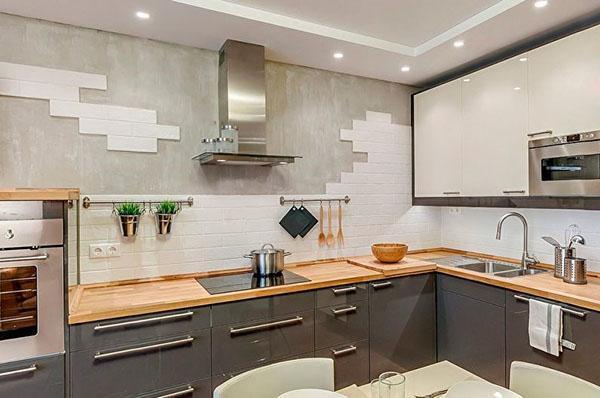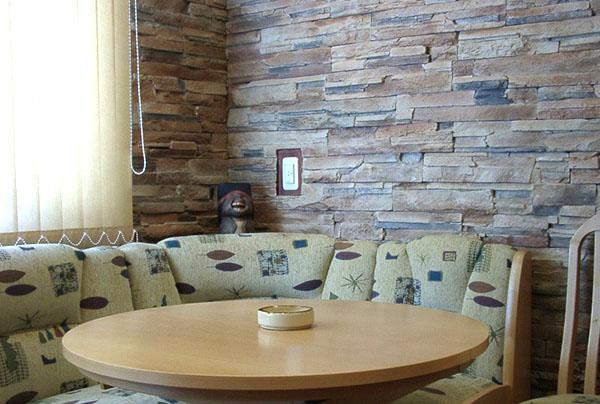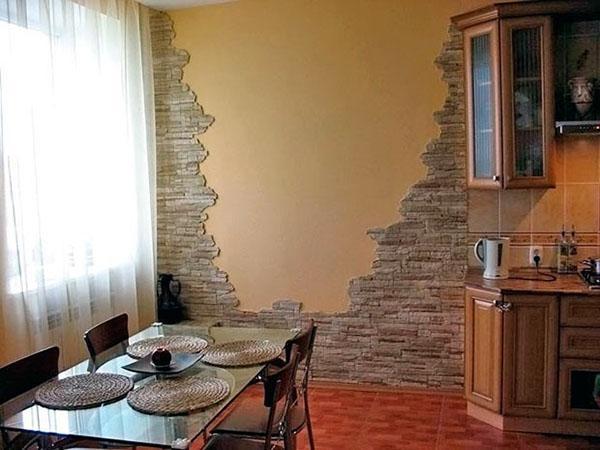Wall decoration in the kitchen: an overview of current options
 Decorating walls in a kitchen is not an easy task due to the specifics of this room. High humidity and temperature extremes impose strict requirements on the choice of materials.
Decorating walls in a kitchen is not an easy task due to the specifics of this room. High humidity and temperature extremes impose strict requirements on the choice of materials.
It is also important to create a cozy atmosphere for family meals and to set aside a place to prepare meals. Is it possible to combine functionality and originality of design in the decoration of walls in the kitchen?
Wall decoration in the kitchen: material requirements

Their observance will help to complete a high-quality kitchen finish:
- resistance to household chemicals intended for cleaning;
- strength;
- maintaining a presentable appearance for a long time;
- external appeal;
- reliability;
- harmony of combination with furniture and style of decoration;
- preservation of quality indicators of finishing materials.
The kitchen should not contain types of finishes that contribute to the development of pathogenic microorganisms.
To create an interior that is interesting in terms of design, it is recommended to use several types of materials, combining them with each other.
A modern finish that meets all the requirements can be organized using the following means:
- brick (red or white);
- wild stone (natural or artificial);
- tile;
- PVC panels;
- mosaic panels;
- decorative plaster and others.
Finishing materials for the kitchen: what is hidden behind the visual appeal
There are a lot of options for finishing the kitchen. Their variety allows you to embody the most daring ideas and make the kitchen interior practical and beautiful.
Artificial stone: is imitation so good

Fake diamond makes it possible to create an interesting decorative design. It blends well with other finishes to create original accents.
This material has many advantages:
- strength;
- long service life;
- light weight;
- environmental friendliness;
- ease of care.
For wall decoration in the kitchen, it is necessary to give preference to moisture-resistant material.
Tile is the most popular option
 Decorative tiles for the kitchen are one of the most popular approaches to decoration. This material has an optimal ratio of price and quality, moreover, it is suitable for almost any interior.
Decorative tiles for the kitchen are one of the most popular approaches to decoration. This material has an optimal ratio of price and quality, moreover, it is suitable for almost any interior.
The tiles for the kitchen must meet all the requirements for the material for the kitchen apron.
Choosing a tile size is also important. More is not always better, especially for a small kitchen.
The smaller the size of the selected tile, the visually larger the kitchen appears.
The choice of the style and color of the tiles should be carried out taking into account the entire composition of the furniture of the working area, including facades and countertops. If bright accents are already outlined in the kitchen, then it is best to choose a single-color tile. It is better to minimize the number of catchy inserts in the wall decoration.
Purchase rules
 When choosing a tile, it is important to purchase a quality product that is free from defects. The calculation of the amount of material required should be increased by at least 10%.
When choosing a tile, it is important to purchase a quality product that is free from defects. The calculation of the amount of material required should be increased by at least 10%.
The smoother the texture of the tile, the easier it is to clean.
Mosaic - creating accents
 Fully mosaic kitchen wall coverings are very rare. It works best for creating trendy accents.The choice of mosaics is simply huge, it comes in various colors and textures.
Fully mosaic kitchen wall coverings are very rare. It works best for creating trendy accents.The choice of mosaics is simply huge, it comes in various colors and textures.
The material for its manufacture can be:
- natural or artificial stone;
- tile;
- wood;
- plastic;
- glass.
Most often, a mosaic canvas is used to decorate a kitchen apron. But it can be used in the eating area and even be used in countertops.
The shape of the mosaic is not necessarily a rhombus or a square, a round, oval and complex shape looks very interesting.
Brick: real or imitation
 When choosing finishing materials for the kitchen wall, you can organize brickwork (real or imitation in the form of panels). When choosing between natural brick and imitation, the first option clearly wins, creating a special flavor.
When choosing finishing materials for the kitchen wall, you can organize brickwork (real or imitation in the form of panels). When choosing between natural brick and imitation, the first option clearly wins, creating a special flavor.
Both the entire wall and a separate fragment can be decorated with bricks. If the kitchen design requires the presence of only certain colors in the decoration, the brick can be painted.
When used for brick decoration, the masonry surface must be treated with a special compound.
Plastic panels
 Plastic on kitchen walls in the form of PVC panels is often chosen for cladding. The surface of such material is well cleaned and resistant to moisture.
Plastic on kitchen walls in the form of PVC panels is often chosen for cladding. The surface of such material is well cleaned and resistant to moisture.
The main disadvantage of plastic is the lack of resistance to high temperatures.
Lining: the relevance of natural materials
 Wood paneling in the kitchen adds coziness to the room and is often used to decorate the dining area. In the building materials market, you can choose a tree of a suitable texture and color.
Wood paneling in the kitchen adds coziness to the room and is often used to decorate the dining area. In the building materials market, you can choose a tree of a suitable texture and color.
The main advantages of the material:
- firmness;
- naturalness;
- attractiveness.
The selection of the type of wood (pine, alder) and profile is carried out according to individual requirements, taking into account the design and the planned effect.
This could be:
- imitation of logs;
- euro profile;
- seamless lining.
To facilitate the cleaning process, the lining must be covered with a protective layer of varnish.
Decorative plaster - textured wall treatment

Plastering of walls in the kitchen is applied in several layers:
- Priming.
- Base.
- Decorative.
Compositions on a natural basis or artificial can be used as a material. Most Popular:
- Silicone (based on synthetic resins).
- Acrylic (based on acrylic resins).
- Mineral (dry material with the addition of crumbs (granite or marble)).
- Silicate (based on liquid glass).
There are several ways to apply plaster for wall decoration in the kitchen:
| P / p No. | Imitation type | Features: |
| | Fabric (velvet, silk) | Material with low wear resistance. The composition contains mother-of-pearl to enhance the visual effect. |
| 2. | Sgraffito | Imitation of an aged surface by overlaying several layers of different shades using a stencil on top |
| 3. | Natural stone (Moroccan, Venetian plaster) | Imitation of the texture of marble and other stones. To apply this type of wall decoration in the kitchen, the surface must be leveled |
| 4. | Concrete | Surface roughness is achieved using inclusions (pebbles, sand) |
Coloring: what could be more concise
 A minimalistic and very budgetary design option is painting. In this case, the decorative wall in the kitchen benefits from the play of colors. A feature of this method is the requirements for a perfectly flat surface.
A minimalistic and very budgetary design option is painting. In this case, the decorative wall in the kitchen benefits from the play of colors. A feature of this method is the requirements for a perfectly flat surface.
Glass: fashionable and stylish design
 Tempered glass is one of the original solutions in the design of the apron of the working area. This material lends itself well to cleaning and allows you to create incredibly beautiful effects on the wall.
Tempered glass is one of the original solutions in the design of the apron of the working area. This material lends itself well to cleaning and allows you to create incredibly beautiful effects on the wall.
Practical advice: how to prevent mistakes
 When starting to repair the kitchen, it is advisable to adhere to simple recommendations that will help to avoid very serious mistakes.
When starting to repair the kitchen, it is advisable to adhere to simple recommendations that will help to avoid very serious mistakes.
Kitchen cladding tips:
- Repair work should be started only after design.
- The calculated amount of material must be purchased immediately, since in case of a shortage of it, it may be difficult or even impossible to purchase the missing amount (for example, in the case of discontinuation of production).
- The materials for the kitchen apron should be subject to increased requirements in terms of practicality.
- Zoning of the total area must be carried out before purchasing material.
- The easier the surface is to maintain, the easier it is to keep it clean.
- The attractiveness of the finish is just as important as the functionality. According to statistics, a person spends a lot of time in the kitchen.
There are many ways to decorate kitchen walls. Knowledge of the properties of materials and adherence to recommendations for choosing a finish will help to competently draw up an interior.